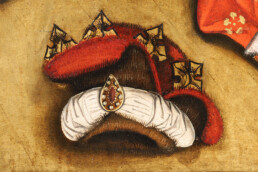The Black King at the Manger
The Magi – the theme is omnipresent in Christian art, in popular nativity scenes and in the tradition of the carol singers. The “Adoration of the Magi” is one of the most popular pictorial themes in art history. The Bible speaks of astrologers from the East, so they have been depicted as pagans with Phrygian caps since the 4th century. From apocryphal writings, the interpretations of the Church Fathers and numerous legends, the idea developed that kings in all three ages were gathered in the Bethlehem stable. Since the late 10th century, there have been depictions of a mostly kneeling old man, a middle-aged man and a young man. Since the late Middle Ages, the latter has been painted with black skin, especially in German-speaking countries. The kings wear splendid courtly clothes and bring valuable gifts, of which the Bible already tells. The Diocesan Museum has several paintings in its collection that show this pictorial tradition.
Today, however, the pictorial theme has become problematic. In the course of modern art history, the black king has become increasingly exoticised and a projection surface for the foreign. Does this form of representation show the artistic joy of the Oriental or is it racist? How should we classify these representations today? How can we deal with them?
In this exhibition, the Diözesanmuseum Rottenburg explores the subject of the “Adoration of the Magi” on the basis of its own works of art and also shows a modern interpretation by Otto Dix. The accompanying programme searches for historical interpretations and contemporary dialogue partners. The aim is to bring together the different perspectives and to bring them into conversation with each other.





